Global Hematology Analyzers and Reagents Market By Product Type, By Technology, By End User, By Region & Segmental Insights Trends and Forecast, 2024 – 2034
- Industry: Healthcare
- Report ID: TNR-110-1251
- Number of Pages: 420
- Table/Charts : Yes
- August, 2024
- Base Year : 2024
- No. of Companies : 10+
- No. of Countries : 29
- Views : 10072
- Covid Impact Covered: Yes
- War Impact Covered: Yes
- Formats : PDF, Excel, PPT
The global hematology analyzers and reagents market is experiencing robust growth driven by technological advancements and increasing healthcare demands. Key growth drivers include the rising prevalence of blood disorders, advancements in diagnostic technologies such as AI and automation, and a growing aging population. The market is trending towards the adoption of sophisticated technologies like flow cytometry and microfluidics, which enhance diagnostic accuracy and efficiency.
Opportunities abound in expanding emerging markets, where healthcare infrastructure improvements are increasing access to advanced diagnostics. Integration with digital health solutions and a focus on personalized medicine further present significant growth prospects. However, challenges such as high costs, regulatory hurdles, and market fragmentation must be navigated to capitalize on these opportunities and drive sustained market expansion. In terms of revenue, the global hematology analyzers and reagents market was worth US$ 5.2 Bn in 2023, anticipated to witness a CAGR of 7.3% during 2024 – 2034.
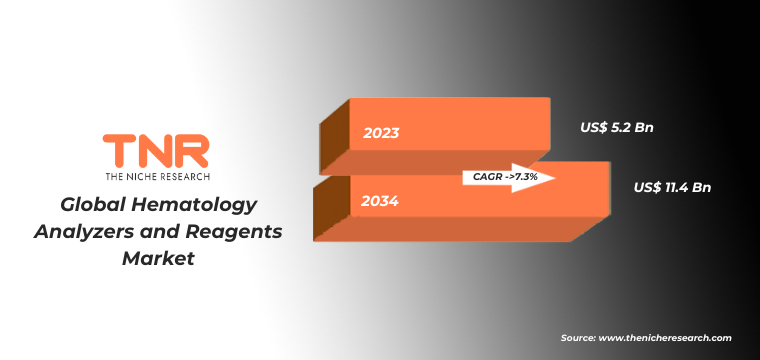
Trends in the Global Hematology Analyzers and Reagents Market
Technological Integration and Automation: The global hematology analyzers and reagents market is increasingly embracing technological integration and automation. Advanced technologies, including artificial intelligence (AI), robotics, and automation systems, are transforming the landscape by improving the accuracy and speed of blood tests. Automated analyzers can process large volumes of samples with high precision, reducing human error and operational costs. AI-driven solutions enhance data analysis, enabling more accurate diagnostic insights and personalized treatment plans. The integration of these technologies streamlines workflows, supports high-throughput testing, and provides real-time results. This trend reflects the broader shift towards efficiency and innovation in medical diagnostics, driving significant growth and setting new industry standards.
Expansion in Emerging Markets: Emerging markets are becoming a significant focus in the global hematology analyzers and reagents market. Rapid healthcare infrastructure development, increasing investments in medical technology, and rising awareness of health issues are driving this expansion. Countries in regions such as Asia-Pacific, Latin America, and the Middle East are experiencing growing demand for advanced diagnostic solutions due to improving healthcare systems and rising incidences of blood disorders. Local manufacturers are also entering the market, providing cost-effective solutions tailored to regional needs. This trend presents substantial growth opportunities for global companies to expand their footprint and collaborate with local players, addressing diverse market requirements and increasing access to quality diagnostics.
Global Hematology Analyzers and Reagents Market Revenue & Forecast, (US$ Million), 2016 – 2034
Hematology analyzers segment have seen a surge in popularity recently, emerging as the fastest-growing segment in the global hematology analyzers and reagents market. This growth is driven by their ability to deliver rapid, accurate, and comprehensive blood analysis, which is essential for diagnosing and managing a wide range of hematological disorders. Technological advancements, such as automation and AI integration, have enhanced the efficiency and precision of these analyzers, making them indispensable in clinical settings. Additionally, the increasing prevalence of blood-related diseases and the demand for routine diagnostic testing contribute to the segment’s expansion. As healthcare systems globally prioritize efficient diagnostic solutions, hematology analyzers are positioned at the forefront of market growth and innovation.
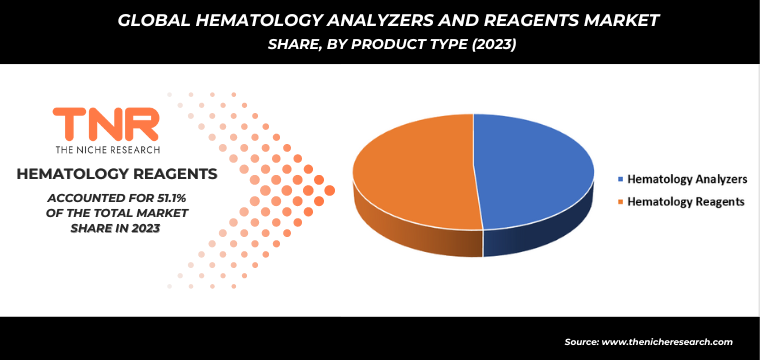
In 2023, impedance technology segment by technology category led the global hematology analyzers and reagents market, commanding a significant revenue share of 39.3%. This technology, which measures changes in electrical impedance as blood cells pass through an aperture, remains the leading choice due to its reliability, accuracy, and cost-effectiveness. Impedance technology provides essential metrics such as cell count and volume, making it suitable for routine diagnostic applications in hospitals and laboratories. Its widespread adoption is driven by its established performance in delivering precise blood analysis results at a lower operational cost compared to newer technologies. The segment’s continued dominance highlights its critical role in supporting high-throughput and efficient hematological testing worldwide.
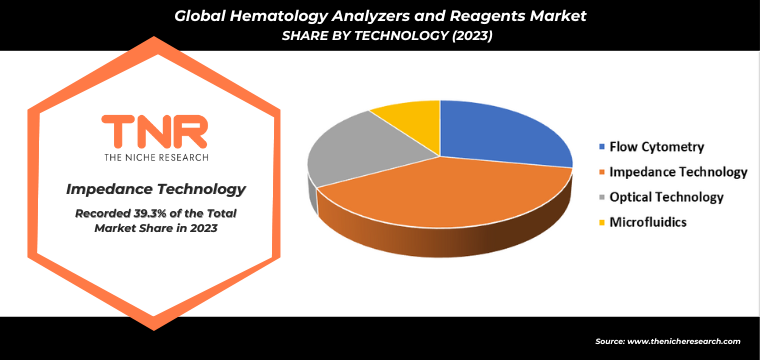
Academic and research institutes segment by end user emerged as the fastest growing segment in the global hematology analyzers and reagents market, capturing a notable revenue share of 16.1%. This growth is attributed to the increasing emphasis on research and development in hematology and related fields. Academic and research institutes are investing in advanced hematology analyzers to facilitate groundbreaking studies, clinical trials, and the development of new diagnostic techniques. The demand for sophisticated analytical tools in these settings supports innovation and enhances the understanding of blood disorders. As research initiatives expand and funding for biomedical research increases, the segment’s rapid growth underscores its vital role in advancing scientific knowledge and improving diagnostic methodologies.
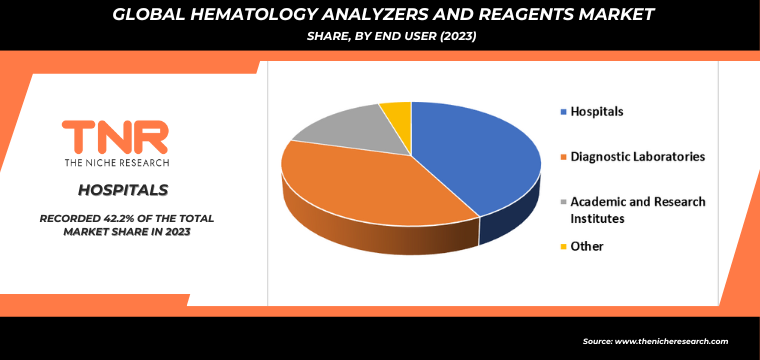
Asia Pacific is anticipated as the fastest growing region during the forecast timeline. This growth is driven by rapid advancements in healthcare infrastructure, increasing investments in medical technology, and a rising prevalence of blood disorders in the region. The expanding healthcare networks and improving access to diagnostic services contribute to the growing demand for sophisticated hematology solutions. Additionally, emerging economies in Asia-Pacific are witnessing enhanced healthcare spending and expanding diagnostic capabilities, further fueling market expansion. The region’s dynamic healthcare landscape, coupled with a large patient population, positions it as a key area of growth and opportunity in the global hematology market.
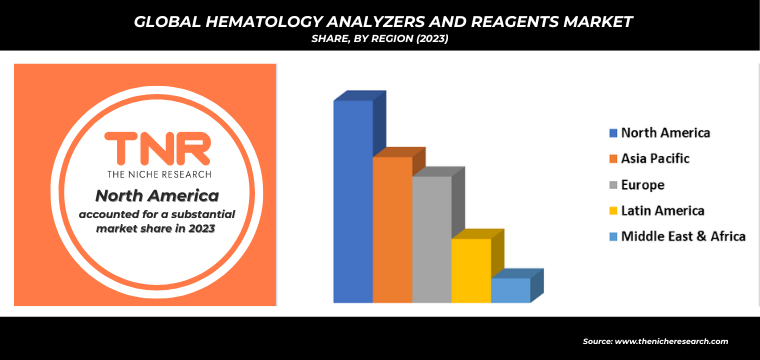
Competitive Landscape
The global hematology analyzers and reagents market features a competitive landscape with numerous key players, including major companies like Siemens, Bio-Rad Laboratories Inc, and Abbott Laboratories. These companies vie for market share through technological innovations, strategic partnerships, and regional expansions. Intense competition drives advancements in diagnostic technologies and improves overall market dynamics.
Some of the players operating in the hematology analyzers and reagents market are
- Abbott Laboratories
- Bio-Rad Laboratories Inc.
- Boule Diagnostics
- Danaher Corporation
- Diatron MI PLC (Stratec SE)
- EKF Diagnostics Holdings plc
- Heska Corporation
- Horiba Ltd.
- Mindray Medical International Limited
- Nihon Kohden Corporation
- Siemens
- Sinnowa Medical Science & Technology Co. Ltd.
- Other Industry Participants
Global Hematology Analyzers and Reagents Market Scope
| Report Specifications | Details |
| Market Revenue in 2023 | US$ 5.2 Bn |
| Market Size Forecast by 2034 | US$ 11.4 Bn |
| Growth Rate (CAGR) | 7.3% |
| Historic Data | 2016 – 2022 |
| Base Year for Estimation | 2023 |
| Forecast Period | 2024 – 2034 |
| Report Inclusions | Market Size & Estimates, Market Dynamics, Competitive Scenario, Trends, Growth Factors, Market Determinants, Key Investment Segmentation, Product/Service/Solutions Benchmarking |
| Segments Covered | By Product Type, By Technology, By End User, By Region |
| Regions Covered | North America, Europe, Asia Pacific, Middle East & Africa, Latin America |
| Countries Covered | U.S., Canada, Mexico, Rest of North America, France, The UK, Spain, Germany, Italy, Nordic Countries (Denmark, Finland, Iceland, Sweden, Norway), Benelux Union (Belgium, The Netherlands, Luxembourg), Rest of Europe, China, Japan, India, New Zealand, Australia, South Korea, Southeast Asia (Indonesia, Thailand, Malaysia, Singapore, Rest of Southeast Asia), Rest of Asia Pacific, Saudi Arabia, UAE, Egypt, Kuwait, South Africa, Rest of Middle East & Africa, Brazil, Argentina, Rest of Latin America |
| Key Players | Abbott Laboratories, Bio-Rad Laboratories Inc., Boule Diagnostics, Danaher Corporation, Diatron MI PLC (Stratec SE), EKF Diagnostics Holdings plc, Heska Corporation, Horiba Ltd., Mindray Medical International Limited, Nihon Kohden Corporation, Siemens, Sinnowa Medical Science & Technology Co. Ltd. |
| Customization Scope | Customization allows for the inclusion/modification of content pertaining to geographical regions, countries, and specific market segments. |
| Pricing & Procurement Options | Explore purchase options tailored to your specific research requirements |
| Contact Details | Consult With Our Expert
Japan (Toll-Free): +81 663-386-8111 South Korea (Toll-Free): +82-808- 703-126 Saudi Arabia (Toll-Free): +966 800-850-1643 United Kingdom: +44 753-710-5080 United States: +1 302-232-5106 E-mail: askanexpert@thenicheresearch.com
|
Global Hematology Analyzers and Reagents Market
By Product Type
- Hematology Analyzers
- Automated Hematology Analyzers
- Semi-Automated Hematology Analyzers
- Hematology Reagents
- Hemoglobin Reagents
- Hematocrit Reagents
- White Blood Cell Count Reagents
- Platelet Reagents
- Others
By Technology
- Flow Cytometry
- Impedance Technology
- Optical Technology
- Microfluidics
By End User
- Hospitals
- Diagnostic Laboratories
- Academic and Research Institutes
- Other
By Region
- North America (U.S., Canada, Mexico, Rest of North America)
- Europe (France, The UK, Spain, Germany, Italy, Nordic Countries (Denmark, Finland, Iceland, Sweden, Norway), Benelux Union (Belgium, The Netherlands, Luxembourg), Rest of Europe)
- Asia Pacific (China, Japan, India, New Zealand, Australia, South Korea, Southeast Asia (Indonesia, Thailand, Malaysia, Singapore, Rest of Southeast Asia), Rest of Asia Pacific)
- Middle East & Africa (Saudi Arabia, UAE, Egypt, Kuwait, South Africa, Rest of Middle East & Africa)
- Latin America (Brazil, Argentina, Rest of Latin America)
Report Layout:
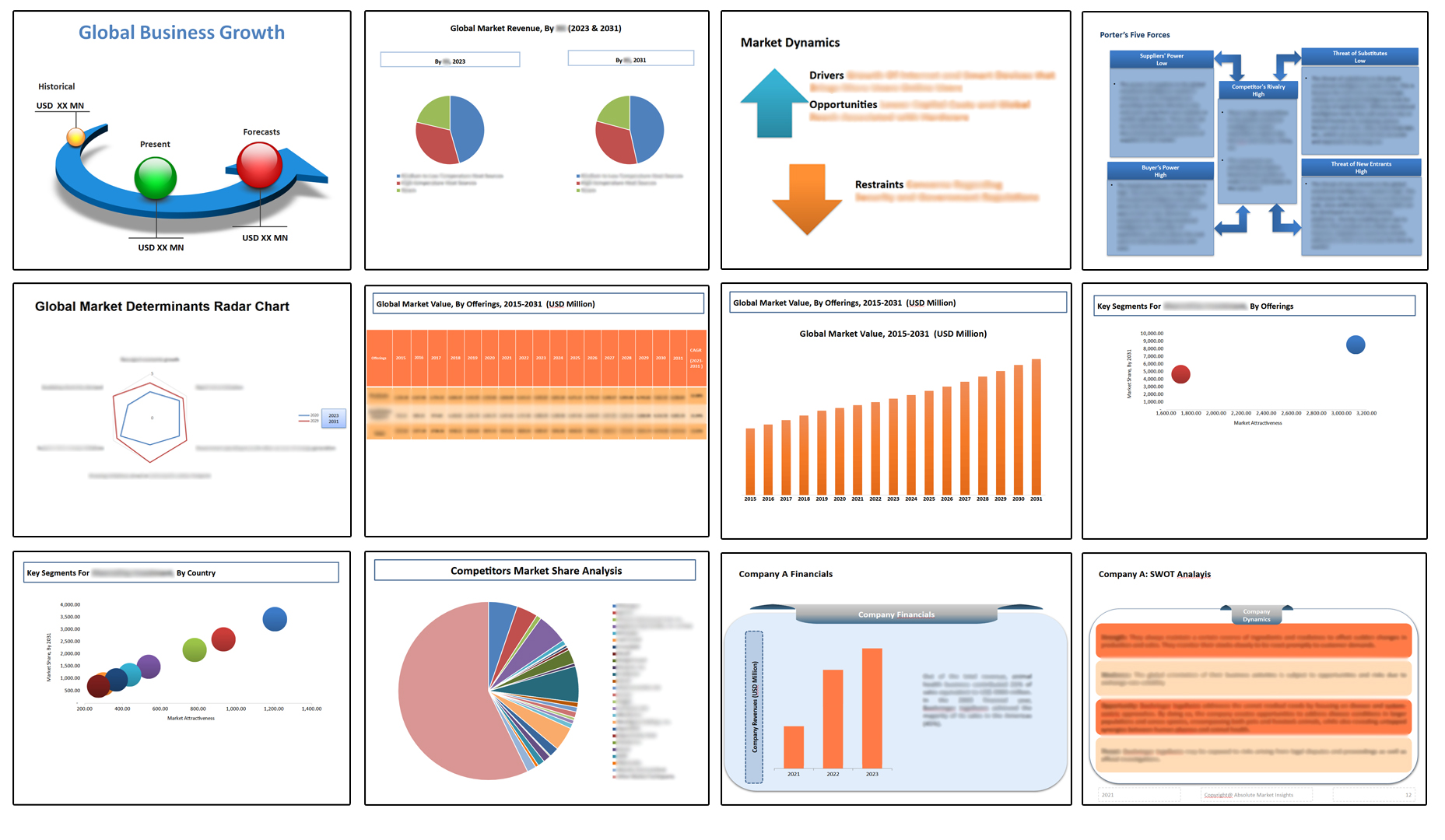
Table of Contents
Note: This ToC is tentative and can be changed according to the research study conducted during the course of report completion.
**Exclusive for Multi-User and Enterprise User.
Global Hematology Analyzers and Reagents Market
By Product Type
- Hematology Analyzers
- Automated Hematology Analyzers
- Semi-Automated Hematology Analyzers
- Hematology Reagents
- Hemoglobin Reagents
- Hematocrit Reagents
- White Blood Cell Count Reagents
- Platelet Reagents
- Others
By Technology
- Flow Cytometry
- Impedance Technology
- Optical Technology
- Microfluidics
By End User
- Hospitals
- Diagnostic Laboratories
- Academic and Research Institutes
- Other
By Region
- North America (U.S., Canada, Mexico, Rest of North America)
- Europe (France, The UK, Spain, Germany, Italy, Nordic Countries (Denmark, Finland, Iceland, Sweden, Norway), Benelux Union (Belgium, The Netherlands, Luxembourg), Rest of Europe)
- Asia Pacific (China, Japan, India, New Zealand, Australia, South Korea, Southeast Asia (Indonesia, Thailand, Malaysia, Singapore, Rest of Southeast Asia), Rest of Asia Pacific)
- Middle East & Africa (Saudi Arabia, UAE, Egypt, Kuwait, South Africa, Rest of Middle East & Africa)
- Latin America (Brazil, Argentina, Rest of Latin America)
The Niche Research approach encompasses both primary and secondary research methods to provide comprehensive insights. While primary research is the cornerstone of our studies, we also incorporate secondary research sources such as company annual reports, premium industry databases, press releases, industry journals, and white papers.
Within our primary research, we actively engage with various industry stakeholders, conducting paid interviews and surveys. Our meticulous analysis extends to every market participant in major countries, allowing us to thoroughly examine their portfolios, calculate market shares, and segment revenues.
Our data collection primarily focuses on individual countries within our research scope, enabling us to estimate regional market sizes. Typically, we employ a bottom-up approach, meticulously tracking trends in different countries. We analyze growth drivers, constraints, technological innovations, and opportunities for each country, ultimately arriving at regional figures.Our process begins by examining the growth prospects of each country. Building upon these insights, we project growth and trends for the entire region. Finally, we utilize our proprietary model to refine estimations and forecasts.
Our data validation standards are integral to ensuring the reliability and accuracy of our research findings. Here’s a breakdown of our data validation processes and the stakeholders we engage with during our primary research:
- Supply Side Analysis: We initiate a supply side analysis by directly contacting market participants, through telephonic interviews and questionnaires containing both open-ended and close-ended questions. We gather information on their portfolios, segment revenues, developments, and growth strategies.
- Demand Side Analysis: To gain insights into adoption trends and consumer preferences, we reach out to target customers and users (non-vendors). This information forms a vital part of the qualitative analysis section of our reports, covering market dynamics, adoption trends, consumer behavior, spending patterns, and other related aspects.
- Consultant Insights: We tap into the expertise of our partner consultants from around the world to obtain their unique viewpoints and perspectives. Their insights contribute to a well-rounded understanding of the markets under investigation.
- In-House Validation: To ensure data accuracy and reliability, we conduct cross-validation of data points and information through our in-house team of consultants and utilize advanced data modeling tools for thorough verification.
The forecasts we provide are based on a comprehensive assessment of various factors, including:
- Market Trends and Past Performance (Last Five Years): We accurately analyze market trends and performance data from preceding five years to identify historical patterns and understand the market’s evolution.
- Historical Performance and Growth of Market Participants: We assess the historical performance and growth trajectories of key market participants. This analysis provides insights into the competitive landscape and individual company strategies.
- Market Determinants Impact Analysis (Next Eight Years): We conduct a rigorous analysis of the factors that are projected to influence the market over the next eight years. This includes assessing both internal and external determinants that can shape market dynamics.
- Drivers and Challenges for the Forecast Period:Identify the factors expected to drive market growth during the forecast period, as well as the challenges that the industry may face. This analysis aids in deriving an accurate growth rate projection.
- New Acquisitions, Collaborations, or Partnerships: We keep a close watch on any new acquisitions, collaborations, or partnerships within the industry. These developments can have a significant impact on market dynamics and competitiveness.
- Macro and Micro Factors Analysis:A thorough examination of both macro-level factors (e.g., economic trends, regulatory changes) and micro-level factors (e.g., technological advancements, consumer preferences) that may influence the market during the forecast period.
- End-User Sentiment Analysis: To understand the market from the end-user perspective, we conduct sentiment analysis. This involves assessing the sentiment, preferences, and feedback of the end-users, which can provide valuable insights into market trends.
- Perspective of Primary Participants: Insights gathered directly from primary research participants play a crucial role in shaping our forecasts. Their perspectives and experiences provide valuable qualitative data.
- Year-on-Year Growth Trend: We utilize a year-on-year growth trend based on historical market growth and expected future trends. This helps in formulating our growth projections, aligning them with the market’s historical performance.
Research process adopted by TNR involves multiple stages, including data collection, validation, quality checks, and presentation. It’s crucial that the data and information we provide add value to your existing market understanding and expertise. We have also established partnerships with business consulting, research, and survey organizations across regions and globally to collaborate on regional analysis and data validation, ensuring the highest level of accuracy and reliability in our reports.









